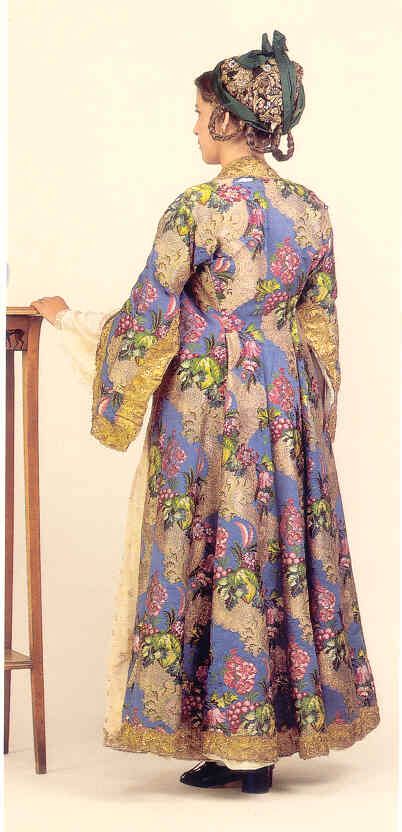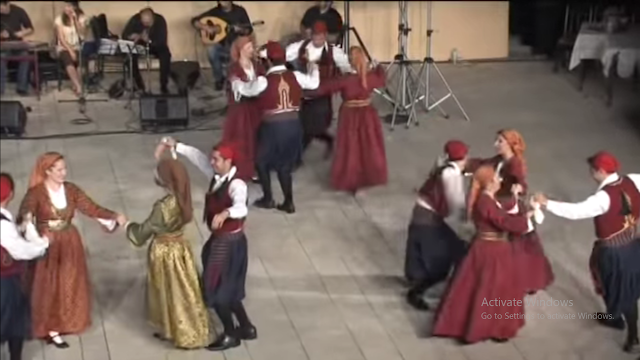Today I will continue my overview of the costumes of the Greek Islands with the Cyclades Islands.
Kyklades Κυκλάδες
https://en.wikipedia.org/wiki/Cyclades
In English usually spelled Cyclades. This group of islands is located to the southeast of the mainland of Attica and Euboea. They are called this because they circle the island of Delos, which was considered sacred in Ancient times. They were the site of a pre Hellenic civilization in the bronze age characterized by stylized sculptures in white marble which appeared very modern to 20th cent eyes. Not all of the islands have retained a folk costume tradition, but some have revived it.
Video taken on Tinos, some dancing at the 1230 mark and later. They are wearing a simplified version of the costume, omitting the kaftan, and wearing a simpler bodice.
Dances from Mykonos in the reconstructed costume.
https://co.pinterest.com/pin/271975264983588379/
Kea Κέα
https://en.wikipedia.org/wiki/Kea_(island
This island is also called Tzia Τζια. This is the northernmost of the second row of islands, to the west of the first row. In ancient times the inhabitants had a special veneration of the star Sirius, seeking for its first rising in summer to foretell the quality of the coming year. In the middle ages, like many neighboring islands it fell first to the Venetians and then the Ottomans. A couple of different costumes are used to represent this island. I am not sure of the difference, except maybe periods in history of fashion.
Kythnos Κύθνος
https://en.wikipedia.org/wiki/Kythnos
This is the next island to the southeast in this second row. A site at Maroulas has been shown to be inhabited already in 10,000 BC. Copper mining and smelting were important in the Bronze Age. Aristotle is said to have praised the government on Kythnos, but this document has been lost to history. This is a picturesque tourist location, the streets in the towns not being amenable to vehicular traffic due to their narrowness and steepness. There seems to be one particular costume native to this island.
https://www.pinterest.es/pin/466474473873552383/
Another dance performance from Kythnos with beautiful woven aprons. A couple of the women are wearing the reconstructed Mykonos costume.
https://www.youtube.com/watch?v=Kj3zReuHDY0
Syros Σύρος
https://en.wikipedia.org/wiki/Syros
Southeast of Kythnos, the next inhabited island is Syros, in ancient times called Syra. The hilltop settlement of Karos dates to 3000 BC, and exemplifies the Cycladic culture. The island was home to Pherecedes, the teacher of Pythagoras. In December of 2018, the authorities on the island announced the official Syros costume, based on historical reconstruction. These are photographs of the ceremony.
Here is a video of this ceremony. Presentations of the costumes [in Greek] starts at the 2000 min mark, a series of dance performances starts at the 3100 mark.
https://www.youtube.com/watch?v=Yqz67MrYPMw&feature=emb_logo
Just for comparison, here is a video of Syros dances taken in 2013
https://www.youtube.com/watch?v=nNK308v1TRI
Serifos Σέριφος
https://en.wikipedia.org/wiki/Serifos
Southwest from Syros lies the island of Serifos, across a channel separating the northern group of islands, which we have just looked at, from the southern. Serifos is the island on which Danae and her infant son Perseus washed up after her father Akrisios set them adrift in a wooden chest in response to a prophecy. In the classic period, Serifos was famous for its frogs being mute. It had iron and copper mines in antiquity, but these were never mentioned by classical authors. The costume of Serifos is of late origin, consisting of a jacket. skirt and apron.
Notice this woman above is wearing a jacket with a peplum that is elongated in the back. The next group of photos show that the costume designer took this as typical of the island.
Here is another stage interpretation of the costume.
https://www.youtube.com/watch?v=I10iHz_7v0o
Here is another video of Serifos dance, with another interpretation of the costume.
https://www.youtube.com/watch?v=BZdtQWXmCqk
Sifnos Σίφνος
https://en.wikipedia.org/wiki/Sifnos
This island lies southeast of Serifos. In antiquity it was very prosperous because it was rich in metals, gold, silver and lead, that were mined there as early as the 3rd millennium BC. It was in the mainstream of the Cycladic Civilization. It has almost as many churches as there are days in the year, and many feasts and festivals take place on the island to this day. The costume of Sifnos is very rich and shows Venetian and Ottoman influences. There must have been a more day to day costume as well.
An old black and white video of a dance in Sifnos.
https://www.youtube.com/watch?v=Bz5B2EmKuuk
A home video of a dance in Sifnos
https://www.youtube.com/watch?v=ZHQ7u0gHWUc
Paros and Antiparos, Πάρος και Αντίπαρος
https://en.wikipedia.org/wiki/Paros
Paros lies east and a little north of Sifnos. In antiquity it was known for its pure white marble, and quarries can still be seen all over the island, mostly abandoned. The marble now belongs to the Greek State, and is used almost exclusively for Archaeological restorations. Its smaller sister island, Antiparos lies just west of Paros. Paros supported the Persians in the Persian/Greek wars, and was afterwards punished by Athens. It was part of the Athenian League until 357 BC. The oldest Church on the island is said to have been founded by St Helen, mother of Emperor Constantine.
The costume consists of a full colored jumper worn over a chemise, with a scarf around the head.
Just a couple of images from Antiparos
https://www.youtube.com/watch?v=tbvYChT0VKY
Dances from Antiparos
https://www.youtube.com/watch?v=1YLvqq6hySQ
Naxos Νάξος
Naxos lies east of Paros. It is the largest of the Cyclades Islands, and was the center of the pre-Hellenic Cycladid Civilization. Naxos was the location of the cave on mount Zas where Zeus was raised. It is the location of the birth of Dionysus, and the island where Theseus abandoned Ariadne. Zas cave, from archaeological finds, was already inhabited in the Neolithic. The costume of Naxos is rather generic, being a skirt with bodice or jacket. There are a couple of interpretations.
Dances from Naxos
https://www.youtube.com/watch?v=zJzKqfbsR-w
And another video of dances from Naxos. This is a closer view, but at night.
https://www.youtube.com/watch?v=uFVuvCHPepQ
And just one more
https://www.youtube.com/watch?v=ZLcMGt2MdPA
Amorgos Αμοργός
https://en.wikipedia.org/wiki/Amorgos
Amorgos lies to the southeast of Naxos, across a straight filled with small islands. It is the easternmost of the Cyclades. Amorgos is exceptionally rich in remains of various civilizations, Minoan, Cycladian, Ionic, The famous temple of Aphrodite at Aspis was on this island. A famous ancient Christian ikon is housed in the cliffside monastery of Panagia Khozoviotissa, and may be viewed by visitors. A famous old costume is preserved in the local museum, which is used as inspiration for contemporary dance groups.
Dances from Amorgos
https://www.youtube.com/watch?v=6r_4EzgQ7sc
Another dance group from Amorgos
https://www.youtube.com/watch?v=6rJlg7CMN08
The men's dance native to the island, Niketre.
https://www.youtube.com/watch?v=Im3oE9PPp4Q
Ios or Nios Ίος ή Νιός
https://en.wikipedia.org/wiki/Ios
This island lies west of Amorgos and south of Naxos. The island is named after violets which are common there. Local dishes are goat cheese and stuffed pumpkin flowers. Ios was successively part of the Cycladian, Minoan, Mycenaean, Phoenecian, Ionic, Athenian and Venetian civilizations. Homer is said to have travelled to Ios, died there, and is figured much on the island, starting with coins in the 3rd century BC. Today the island continues to be popular with travelers. The old costume of Ios resembles that of Sifnos.
An old video of dancing on Ios. This clip is very short, but the only one I could find.
https://www.youtube.com/watch?v=aXlrnfzDvKo
Santorini or Thira Σαντορίνη ή Θήρα
https://en.wikipedia.org/wiki/Santorini
This island lies directly south of Ios, and is the southernmost island of the Cyclades group. The official name of the island is Thira, but one of the old names, Santorini, a contraction of Saint Irene, is still often used. Thira is most famous as the site of one of the largest eruptions in recorded history, which took place in roughly 1600 BC. The caldera is now underwater, and Thira forms a large part of the rim. Excavations at Akrotiri show the amazing Minoan civilization, trapped in time much like Pompeii, only over a thousand years older. Achaeologists have uncovered shops and homes with running water and indoor toilets.
Dances from Santorini
https://www.youtube.com/watch?v=N7uKVAMiBKc
Dance from Santorini
https://www.youtube.com/watch?v=oqVwMTvzWlk
Anafi Ανάφη
https://en.wikipedia.org/wiki/Anafi
This is a small island which lies east of Thira. The Argonauts, under the guidance of Apollo, took refuge there from a storm. There is a written record from 1884 by the travelling Bents family which describes the old costume. They also mention that the woman who showed them the costume was much made fun of, and unfortunately, this description is all that remains. http://tambent.com/2018/04/26/incidentally-iii-margaret-kenna-and-the-bents-on-anafi-in-1884/
Here is a dance performance by a children's group on Anafi.
https://www.youtube.com/watch?v=YPmDazPngNQ
Kimolos Κίμωλος
https://en.wikipedia.org/wiki/Kimolos
Kimolos is southwest of Ios, near the larger island of Milos. It has been the site of many battles throughout history. I have found only a couple of drawings of the old costume of this island. In these drawings the island is called Argentiere.
Here is a dance video from Kimilos
https://www.youtube.com/watch?v=TKXS7U7iwjs&feature=emb_logo
Here is another dance video, but the dancers are wearing costumes that resemble those of Sifnos or Ios.
https://www.youtube.com/watch?v=OcFg92gU57E
Milos Μήλος
https://en.wikipedia.org/wiki/Milos
Milos lies to the southwest of Kimilos, and is the last inhabited Cyclades island in that direction. The statues of Venus [Aphrodite] and Asklepios of Milo were found on this island. The island has been inhabited since the bronze age, and tuna fishing has been carried on since. After hosting the Cycladian and Mycenaean cultures, the island was settled by the Dorian Greeks. Old drawings show a costume that was similar to others in the central Cyclades, especially to the reconstructed costume of Mykonos.
Dance performance on Milos. The dancers at the beginning are wearing the Naxos costume, and then do a longer performance of Epirot dances.
https://www.youtube.com/watch?v=ttvpM6jfJZs&t=622s
There are a couple of other inhabited islands in the Cyclades, Folegandros, and Sikinos, but I have been unable to find any costume material from them.
This is the end of the second part of this article on the Greek Islands
Thank you for reading, I hope that you have found this to be interesting and informative.
Roman K
email: rkozakand@aol.com































































































































































































https://images.app.goo.gl/8awgik6spiq8aiRs7 Very nice work. But you have to add traditional women's costumes form Filoti of Naxos. Women used to wear silk taffeta dress, silk black jacket with Balck embroidery and silk black podhia with embroidery.
ReplyDeletehttps://pin.it/4CfhopW At Chora of Naxos the upper class ladies used to wear this costume
ReplyDeleteRollercoin's https://rollercoin.com/ online Bitcoin mining simulator is a true hidden gem! Earning Bitcoin while playing games is like a dream come true. Your mentioned blog had all the details I needed to kickstart this journey. The competitive aspect adds a fun twist, making it an educational game with real rewards. Thanks a bunch for sharing this fantastic discovery!
ReplyDeleteHoraCredit’s credite rapide ifn on card option is a game-changer! I was amazed at how quickly the money was transferred directly to my card. No long waits, no unnecessary paperwork—just quick, easy access to the funds I needed. I highly recommend this service if you’re in a pinch and need fast financial assistance.
ReplyDelete